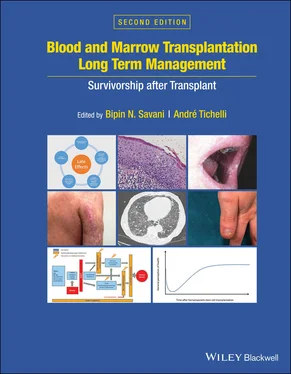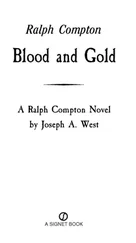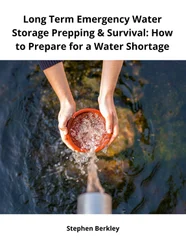Ongoing research is focused on better understanding of late effect issues and predictionof posttransplant long‐term complications, which allows transplant‐eligible patients to incorporate this knowledge into more informative decision making [18,23]. Therefore, significant resources should be focused on the better implementation of how patients and physicians use extensive data regarding posttransplant late complications in clinical care.
With survivorship, a shift in care occurs from large transplant centers to community healthcare providers. As a result, many hematologist/oncologist and primary care physicians are assuming the posttransplant care of long‐term survivors. Preventive measures, as well as early detection and treatments, are important aspects to reducing morbidity and mortality in long‐term survivors after HCT. This book [17] offers the updated practical advice and outlines late effect experts’ personal approaches in managing long‐term survivors after HCT. The management of late HCT effects is important to improve long‐term survival of HCT recipients but should be tailored to the risks specific to the primary disease and transplant type. Future planning should account for the impact of the expected increase in transplant activity and number of survivors on resource utilization.
We also recommend early referral or discussion with a transplant center for enrolment of patients in available late effect studies and for management guidelines. A better understanding of the pathogenesis of late effects will allow for more effective screening to identify patients at risk prior to the HCT procedure, and allow more effective monitoring to detect early evolution of the late effects after HCT. This may, in turn, allow for improved therapeutic decision making while evaluating patients for HCT, and early institution of treatments directed at preventing and treating late effects in patients at risk after HCT. To better inform the needs of the contemporary HCT survivor generation and guide the delivery of late effects services, periodic analysis of new survivor cohorts is needed.
Declaration of commercial interest
None.
1 1. D'Souza A, Fretham C, Lee SJ, et al. Current use of and trends in hematopoietic cell transplantation in the United States. Biol Blood Marrow Transplant, 2020.
2 2. Blume KGT, E. D. Chapter 1: A history of allogeneic and autologous hematopoietic cell transplantation (ed Fifth). Oxford, UK, John Wiley & Sons, Ltd, 2015 pp. 1–11
3 3. Horowitz MM. Chapter 2: Uses and Growth of Hematopoietic Cell Transplantation (ed Fifth). Oxford, UK, John Wiley & Sons, Ltd, 2015 pp. 8–17.
4 4. Savani BM (Editor). Blood and marrow transplantation long‐term management: prevention and complications (ed First). Oxford, UK, John Wiley & Sons, Ltd, 2013.
5 5. Shah NN, Ahn KW, Litovich C, et al. Allogeneic transplantation in elderly patients >/=65 years with non‐Hodgkin lymphoma: a time‐trend analysis. Blood Cancer J 9:97, 2019.
6 6. Cooper JP, Storer BE, Granot N, et al. Allogeneic hematopoietic cell transplantation with non‐myeloablative conditioning for patients with hematologic malignancies: Improved outcomes over two decades. Haematologica, 2020.
7 7. Canaani J, Beohou E, Labopin M, et al. Trends in patient outcome over the past two decades following allogeneic stem cell transplantation for acute myeloid leukaemia: an ALWP/EBMT analysis. J Intern Med 285:407–418, 2019.
8 8. Bakhtiar S, Salzmann‐Manrique E, Hutter M, et al. AlloHSCT in paediatric ALL and AML in complete remission: improvement over time impacted by accreditation? Bone Marrow Transplant 54:737–745, 2019
9 9. Khoury HJ, Wang T, Hemmer MT, et al. Improved survival after acute graft‐versus‐host disease diagnosis in the modern era. Haematologica 102:958–966, 2017.
10 10. Kanate AS, Majhail NS, Savani BN, et al. Indications for Hematopoietic Cell Transplantation and Immune Effector Cell Therapy: guidelines from the American Society for Transplantation and Cellular Therapy. Biol Blood Marrow Transplant 26:1247–1256, 2020.
11 11. Hashmi S, Carpenter P, Khera N, et al. Lost in transition: the essential need for long‐term follow‐up clinic for blood and marrow transplantation survivors. Biol Blood Marrow Transplant 21:225–232, 2015.
12 12. Hashmi SK, Lee SJ, Savani BN, et al: ASBMT Practice Guidelines Committee Survey on Long‐Term Follow‐Up Clinics for Hematopoietic Cell Transplant Survivors. Biol Blood Marrow Transplant 24:1119–1124, 2018.
13 13. Savani BN, Griffith ML, Jagasia S, et al. How I treat late effects in adults after allogeneic stem cell transplantation. Blood 117:3002–3009, 2011.
14 14. Majhail NS, Rizzo JD, Lee SJ, et al. Recommended screening and preventive practices for long‐term survivors after hematopoietic cell transplantation. Biol Blood Marrow Transplant 18:348–371, 2012.
15 15. Bhatia S, Armenian SH, Landier W. How I monitor long‐term and late effects after blood or marrow transplantation. Blood 130:1302–1314, 2017.
16 16. Inamoto Y, Lee SJ. Late effects of blood and marrow transplantation. Haematologica 102:614–625, 2017.
17 17. Savani BN, Tichelli A (Editors). Blood and marrow transplantation long‐term management: prevention and complications (ed Second). Oxford, UK, John Wiley & Sons, Ltd, 2020.
18 18. Battiwalla M, Hashmi S, Majhail N, et al. National Institutes of Health Hematopoietic Cell Transplantation Late Effects Initiative: developing recommendations to improve survivorship and long‐term outcomes. Biol Blood Marrow Transplant 23:6–9, 2017.
19 19. Martin PJ, Counts GW, Jr., Appelbaum FR, et al. Life expectancy in patients surviving more than 5 years after hematopoietic cell transplantation. J Clin Oncol 28:1011–1016, 2010.
20 20. Bhatia S, Francisco L, Carter A, et al: Late mortality after allogeneic hematopoietic cell transplantation and functional status of long‐term survivors: report from the Bone Marrow Transplant Survivor Study. Blood 110:3784–3792, 2007.
21 21. Palmer J, Chai X, Pidala J, et al: Predictors of survival, nonrelapse mortality, and failure‐free survival in patients treated for chronic graft‐versus‐host disease. Blood 127:160–166, 2016.
22 22. Sun CL, Francisco L, Kawashima T, et al: Prevalence and predictors of chronic health conditions after hematopoietic cell transplantation: a report from the Bone Marrow Transplant Survivor Study. Blood 116:3129–3139; quiz 3377, 2010.
23 23. Battiwalla M, Tichelli A, Majhail NS. Long‐term survivorship after hematopoietic cell transplantation: roadmap for research and care. Biol Blood Marrow Transplant 23:184–192, 2017.
CHAPTER 2 International Blood and Marrow Registries: trends on long‐term data collection
Rachel Phelan1, Jakob R. Passweg2, Helen Baldomero2, Minako Iida3, Yoshiko Atsuta4, Shinichiro Okamoto5, Mahmoud Aljurf6, Feras Alfraih6, and Bronwen E. Shaw1
1Center for International Blood and Marrow Transplant Research; Department of Medicine, Medical College of Wisconsin, Milwaukee, WI, USA
2Division of Hematology, University Hospital Basel, Basel, Switzerland
3Department of Promotion for Blood and Marrow Transplantation, Aichi Medical University School of Medicine, Nagakute, Japan
4Japanese Data Center for Hematopoietic Cell Transplantation (JDCHCT), Nagoya, Japan
5Division of Hematology, Department of Medicine, Keio University School of Medicine, Tokyo, Japan
6Oncology Center, King Faisal Specialist Hospital & Research Center, Riyadh, Saudi Arabia
Overview of the Role of Registries in HCT
Registries focused on data collection specific to hematopoietic cell transplant (HCT) recipients have been in place since the late 1960s. These databases are instrumental in research efforts to understand outcomes over time for those receiving an HCT [1,2]. They allow analyses based on pre‐ and posttransplant variables, including histocompatibility, choice of conditioning regimen, donor sources, disease type and the development of transplant‐related complications. These databases have been used in a multitude of published retrospective studies, which have informed clinical practice over the years [3–12]. Registry data has helped to inform numerous prospective clinical trials in efforts to improve upon prior outcomes such as overall survival and the development of graft‐vs‐host‐disease (GVHD) and has also been used as a tool for developing prospective clinical trials by providing insight into areas of research need or estimates for potential patient accrual. The Blood and Marrow Transplant Clinical Trials Network (BMT CTN), in collaboration with a well‐established registry, the Center for International Blood and Marrow Transplant Research (CIBMTR), is an example of how ongoing input of registry data can be utilized for this purpose. It is also notable that some registry data is linked to biorepositories, presenting the opportunity for studies focused on issues such as immune reconstitution or genetic predisposition to certain transplant‐related complications or disease relapse.
Читать дальше











